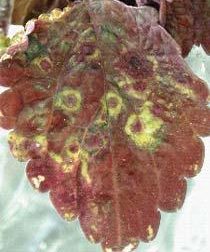
Ann Joy and Brian Hudelson, UW-Madison Plant Pathology
Revised: 5/11/2010
Item number: XHT1139
What is impatiens necrotic spot? Impatiens necrotic spot is a viral disease that causes considerable losses to greenhouse-grown ornamentals and, to a lesser extent, vegetable crops. In Southern states, impatiens necrotic spot can also be a problem on field crops. Ornamental crops affected by impatiens necrotic spot include impatiens, gloxinia, cineraria, cyclamen, exacum, petunia, begonia, primrose and ranunculus. Susceptible vegetables include cucumber, tomato and pepper. Impatiens necrotic spot also affects weeds including chickweed, jewelweed, oxalis, and gill-over-the-ground.
What does impatiens necrotic spot look like? Symptoms vary from species to species and from cultivar to cultivar. Environmental conditions can also influence symptom development. Infected plants may exhibit chlorotic or necrotic spotting; stem, vein or growing point necrosis; ringspots, mosaic or line patterns on leaves; color breaking in flowers; wilting and collapse. Plants that are infected at a young age tend to exhibit more severe symptoms than those infected at an older age. Some plants may remain symptomless, but still can be a source of the causal virus for infecting other plants.
Where does impatiens necrotic spot come from? Impatiens necrotic spot is caused by the impatiens necrotic spot virus (INSV). The primary means of plant-to-plant spread of INSV is by the western flower thrips (Frankliniella occidentalis). This insect acquires INSV when feeding on infected plant sap, carries the virus to its next feeding site, and transmits the virus to the new plant after 15-30 minutes of feeding. Only a few thrips are needed to spread INSV rapidly throughout a greenhouse. Numbers of INSV-infected plants also can be increased simply by taking vegetative cuttings from infected plants.
How do I save a plant with impatiens necrotic spot? After infection, INSV spreads throughout a plant. Therefore plants remain infected indefinitely. Infected plants cannot be treated to remove the virus and should be destroyed by burning, burying or composting.How do I control impatiens necrotic spot in the future? Impatiens necrotic spot control measures concentrate on excluding INSV and preventing its spread. Inspect any plants entering a greenhouse (e.g., new plant shipments, plants moved in from outdoors) for viral symptoms and thrips. Isolate new plants until they are determined to be thrips- and virus-free. In commercial settings, isolate breeding and stock plants from production, and do not carry over plants from fall production into the spring. Destroy any symptomatic plants. Control greenhouse weeds, which can be symptomless reservoirs of INSV. Monitor and control thrips populations. Exclude thrips by screening greenhouse vents and doors (screening should have apertures that are ≤0.135 mm). Set up yellow, white or blue sticky traps to monitor for thrips in growing areas and near entry points. Indicator plants such as Petunia x hybrida ‘Summer Madness’, ‘Super Magic Coral’, or ‘Red Cloud’ (with flowers removed) can provide early warning signs of a problem with infectious thrips. Petunia leaves on which INSV-free thrips feed will develop whitish feeding scars, while those leaves on which INSV-carrying thrips feed will develop small brown to black spots, turning tan with a dark border. See also University of Wisconsin Garden Facts XHT1022 for additional pointers on thrips control, including insecticide recommendations.
Additional Images
Download Article

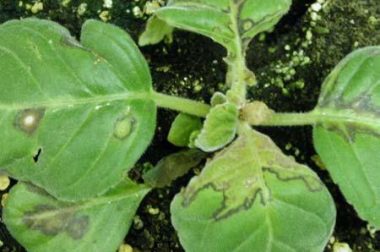




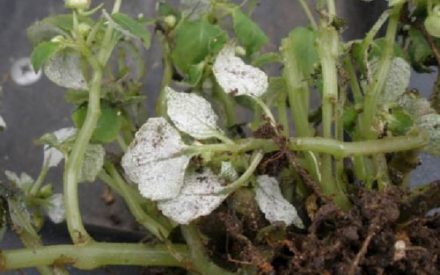 Impatiens Downy Mildew
Impatiens Downy Mildew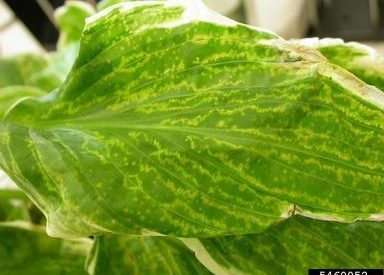 Hosta Virus X
Hosta Virus X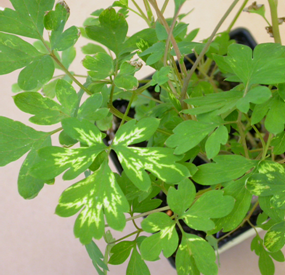 Tobacco Rattle
Tobacco Rattle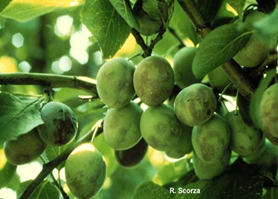 Plum Pox
Plum Pox


